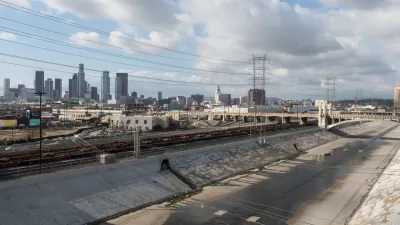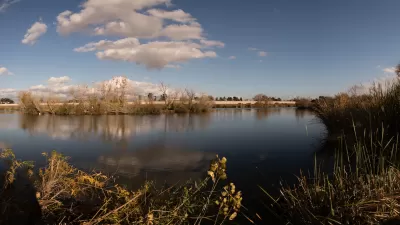In the past, stormwater management has been about flood control. The future of stormwater, however, is in capturing, treating, and recharging water supply, according to this article.

Chris Austin, otherwise known as the Maven of California water news, shares a presentation from Dr. Richard Luthy, a professor of civil and environmental engineering and the director of the National Science Foundation’s Engineering Research Center, describing the evolution of stormwater infrastructure.
According to Luthy, a shift away from stormwater management as flood control would bring multiple benefits. Not only would urban areas like Los Angeles gain critical water supply for a growing population, "it would provide other community benefits, like cleaning the beaches."
Luthy is building on existing plans by the city of Los Angeles to cut the amount of water supply it imports by half:
How is that achieved? One of the solutions is stormwater capture, and on this drawing, it says the stormwater would be 4% of the urban water supply, and in a moment I’ll show you that it could really be much more than that. It could be 3, 4, maybe even 5 times that if plans come into being in this century.”
In addition to an appeal to use bigger systems to achieve more ambitious goals, Luthy also shows how stormwater capture infrastructure can become open space and recreation facilities during dry seasons (e.g., hiking trails, basketball courts, and playfields). Finally, Luthy detailed the processes that would be necessary to treat stormwater runoff that could potentially be contaminated with pathogens, organics, and nitrates.
Renderings, schematics, and other infographics drawn directly from Luthy's presentation supplement the article.
FULL STORY: Stormwater capture, treatment and recharge for urban water supply

Planetizen Federal Action Tracker
A weekly monitor of how Trump’s orders and actions are impacting planners and planning in America.

San Francisco's School District Spent $105M To Build Affordable Housing for Teachers — And That's Just the Beginning
SFUSD joins a growing list of school districts using their land holdings to address housing affordability challenges faced by their own employees.

The Tiny, Adorable $7,000 Car Turning Japan Onto EVs
The single seat Mibot charges from a regular plug as quickly as an iPad, and is about half the price of an average EV.

With Protected Lanes, 460% More People Commute by Bike
For those needing more ammo, more data proving what we already knew is here.

In More Metros Than You’d Think, Suburbs are Now More Expensive Than the City
If you're moving to the burbs to save on square footage, data shows you should think again.

The States Losing Rural Delivery Rooms at an Alarming Pace
In some states, as few as 9% of rural hospitals still deliver babies. As a result, rising pre-term births, no adequate pre-term care and "harrowing" close calls are a growing reality.
Urban Design for Planners 1: Software Tools
This six-course series explores essential urban design concepts using open source software and equips planners with the tools they need to participate fully in the urban design process.
Planning for Universal Design
Learn the tools for implementing Universal Design in planning regulations.
Smith Gee Studio
City of Charlotte
City of Camden Redevelopment Agency
City of Astoria
Transportation Research & Education Center (TREC) at Portland State University
US High Speed Rail Association
City of Camden Redevelopment Agency
Municipality of Princeton (NJ)





























